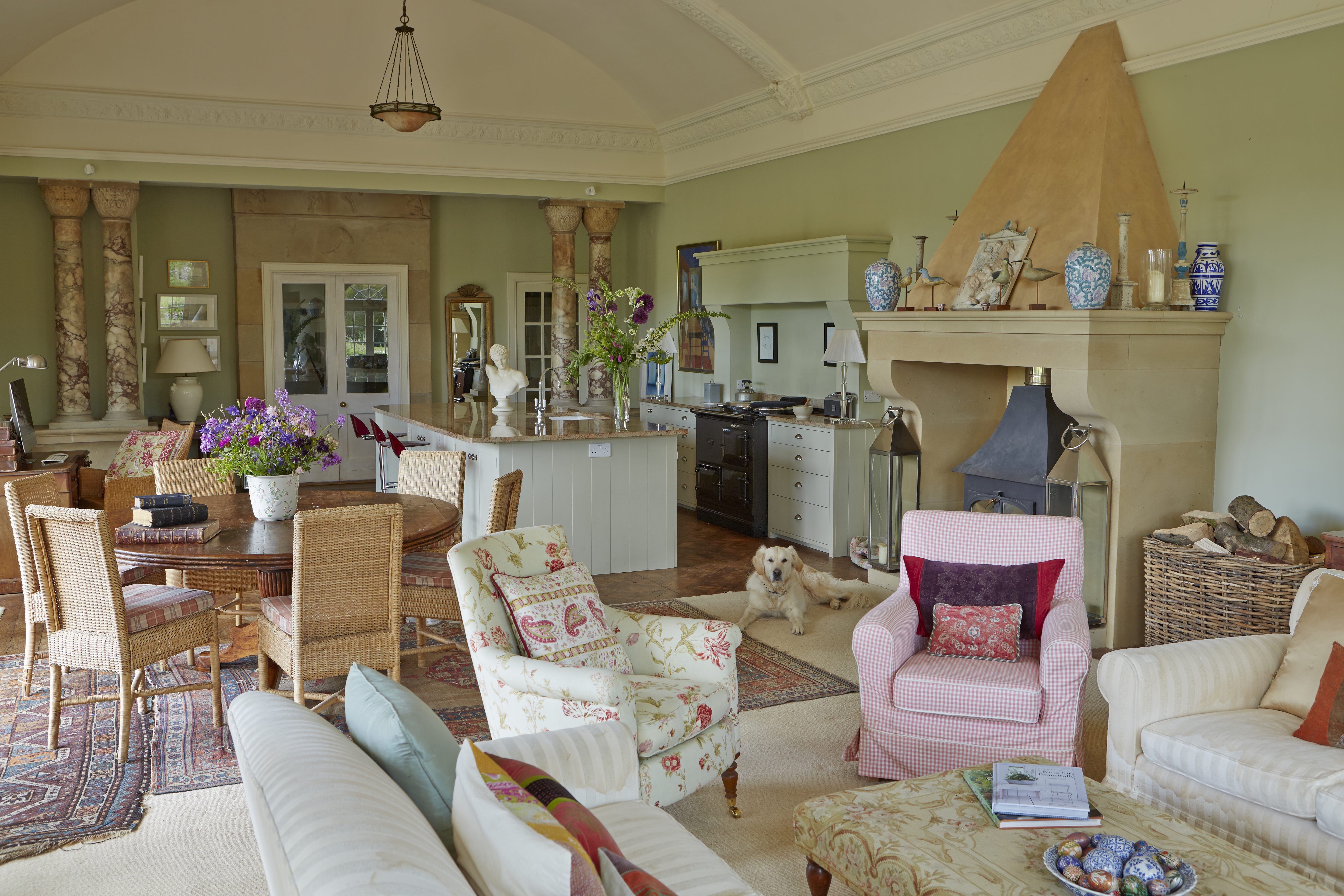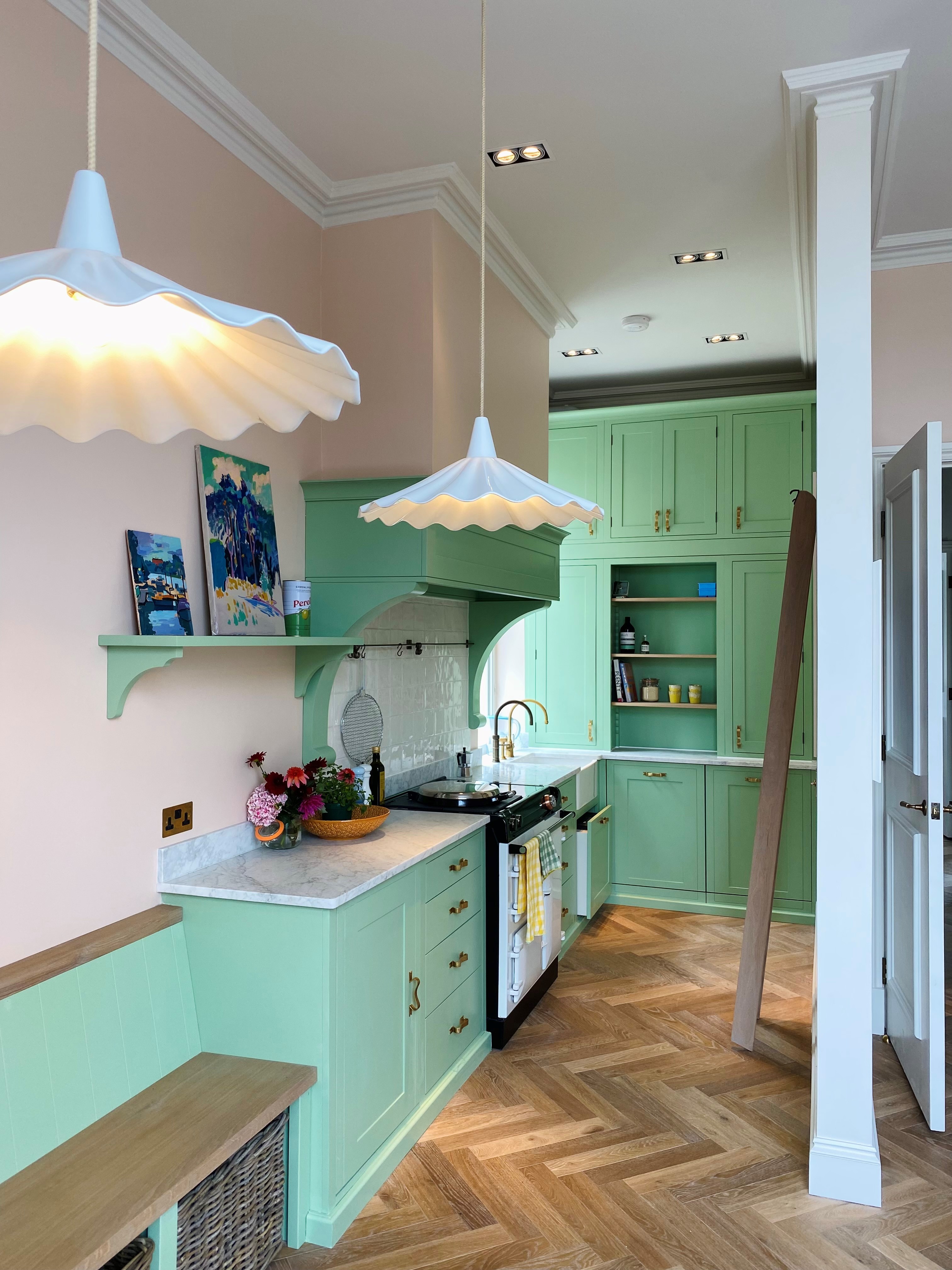Should your kitchen cabinet color match your wall color? Interior designers weigh in
The colors you choose for your kitchen dictate the whole look and feel of the space, so whether to match your cabinet color to the wall is a key design decision...


When designing a new kitchen, what's the most important element? Of course, the style of cabinet you go for has a big impact, and the layout needs to be spot-on, but really it's the kitchen color that makes all the difference. It's what you notice first, it's what your guests notice first, so it's really vital to get your scheme spot on.
Now, there's the obvious question of what kitchen cabinet colors are you going to go for, which seems to rule in the decision-making process, but you really need to decide on your wall color too – at the same time. Do you want your wall color to match the cabinets or not? As with any interior design decision, there's no clear right or wrong answer, however, there are plenty of things to consider when choosing these two colors, no matter which option you are drawn to. So we asked designers to weigh in, what's the best approach to this kitchen color conundrum? Should they match or should they not?
When should you match your kitchen cabinet color and your walls?

As we have mentioned, there's not really any right or wrong decision here, but there are spaces where matching your kitchen cabinets and kitchen wall color will work better than in others. And there are some loose rules to where it's best to take this matchy-matchy approach.
For example in a smaller space embracing that color-drenching interior design trend can do marvelous things. As Anna Hill, color consultant at Fenwick & Tilbrook says: 'While there is no strict rule that dictates an exact match between your kitchen cabinets and wall colors, careful consideration of color harmony and the overall design concept is crucial. Matching the paints on your kitchen cabinets and walls can create a really cohesive and unified look, helping to create a sense of space and continuity. This approach works particularly well in small kitchens as it helps to create a seamless and uncluttered look, making the room feel larger.'
'Painting kitchen cabinets the same color as the walls create a visually calm and contemporary look, which provides a beautiful backdrop to furniture and kitchenalia, rather than letting the cupboards stand out as a feature. This can be particularly useful in a small kitchen space which will seem larger if there are not too many colors competing for space. If this seems too monochrome, why not paint the inside of your cupboards a surprising color?' adds Lena Dahnsjo, color consultant at Edward Bulmer.

Case in point, this modest kitchen is swathed in a beautiful deep blue. The fact that there's no clear distinction between wall and cabinet, and even the ceiling, the dimensions of the room are totally blurred, alluding to more space. It also very much makes the argument that dark shades make for great small kitchen colors.
'Using the same strong cabinetry color on walls and ceiling is an incredibly effective way to trick the eye, enhancing the impression of depth and height. To help balance the dark walls and cabinets in this small kitchen, the color and strength of the backsplash was of utmost importance,' explains Lucy Mayers, decorator at Sibyl Colefax & John Fowler.
Design expertise in your inbox – from inspiring decorating ideas and beautiful celebrity homes to practical gardening advice and shopping round-ups.

There's also the argument that matching your cabinet color to your walls creates a far simpler, sleek space, ideal if you are after a more minimalist kitchen or if you like a more tonal color palette.
'Painting your kitchen walls and cupboards in the same color is a true commitment and will reward you with a cohesive and always impressive look. The all-encompassing color creates an atmosphere of calm where nothing is fighting for dominance,' explains Helen Parker, creative director at deVOL. 'Limited color palettes make styling a room easier too, you can be much more selective, not necessarily keeping to that same color but being a little more restrained with your choices. A rich muted color on the walls and cupboards with flashes of crystal and copper is enough to create drama. Similarly, in a light-colored kitchen, the constraints of using only natural earthy colors help to instantly create a soft and mellow feel.'
Kitchen design Tom Howley agrees: 'Don’t be afraid to use large areas of color in your kitchen. Move away from multiple shades and focus on one key color that will give you consistency and amplify the design. There are no strict rules as to whether painted kitchen cabinets should be the same shade as your walls (or even lighter or darker), it is all down to personal preference. But if you’re looking to create a uniform look, matching the shade of your cabinetry to the color of your walls can be a wonderful way to achieve this, simplifying your scheme and actually making the room feel more spacious.'

Claire Powell, color consultant at Edward Bulmer also makes the very relevant point, that by matching your walls to your cabinets, you allow more space for original features and decor to shine. See how in this traditional kitchen there's so much going on in terms of character, bringing in a second strong color could distract from all the beautiful details of this space.
'Kitchens are very often the hardest room to choose a color for, with all the appliances, kitchenware it can get visually hectic. Painting your kitchen cabinets the same color as the walls will create a lovely, calm feeling. You can see a wonderful use of this in this pale green kitchen, there are many different tones in this room even before you get to the paint; with the marble pillars, furniture, Bath stone fireplace, and wall color, adding color to the cabinets would end up looking rather disjointed.'
'By painting the cabinets the same color as the walls it has opened up the room, the kitchen, dining, and sofa area become one space. Visually the focus is on the natural tones in the stone with the timeless color ‘Eau de Nile’ providing a complementary backdrop. A modern twist whilst on a classic kitchen aesthetic,' she adds.
'It is also a great technique if you are not particularly fond of the style of your cabinets, painting them the same color as the walls to create a camouflage; we advise choosing fun and bright tiles or quirky fabrics and furnishings which will further draw the eye away from those not-so-lovely cabinets, oh and don’t forget the hardware!'
The key thing you will notice with all these kitchens where the cabinets match the wall colors, there is something to break up the block of color. A kitchen backsplash can provide all the contrast needed, and add in some much-needed texture too. Or the kitchen countertop would work too, you just need something to visually interrupt that solid bulk of the same color.
When should you contrast your kitchen cabinets and the walls?

The main plus of having contrast is it of course adds more visual interest and far better highlights your cabinetry. And two-tone kitchens are a huge kitchen trend right now too.
'We more often than not paint our units in a different color to the walls. We do this to enable us to bring in more layers through color to our schemes but also to ensure the room doesn’t feel too flat,' explains Liv Wallers, co-founder of Yellow London.
'We are working on a kitchen at the moment that has a lot of top units and so we have chosen to paint these in the same color as the walls which is a deep neutral color with pink tones (paint and paper library Leather III) and the base units are a rusty red. This is a good way to create a focal point in the kitchen but also means the top units don’t feel too heavy in the room.'

Richard Davonport, managing director at Davonport, agrees that even a subtle, more tonal difference is the better option for kitchen wall and cabinet colors.
'Choosing to match your cabinets to your walls can be one way of establishing a wow factor as it creates a powerful aesthetic punch. However, it can take away from your cabinets, especially if you have chosen to invest in a bespoke and handmade kitchen.'
'If you wish to create a subtle difference, choose the same color with just one shade difference. This creates a new visual rhythm to your kitchen and gives the sense of it being the same color, but without it being overpowering. Choosing a darker shade for your cabinets still allows them to pop against your walls,' he adds.

Adding more colors to a kitchen is also always going to give your space more character and depth as you have more opportunities to bring in color. Even if you don't want to create a super colorful kitchen, just that slight contrast between pink and white or pale blue and cream will up the visual interest.
'Opting for the contrast between your cabinets and walls can be a strategic design choice. Introducing complementary colors or contrasting hues can add depth, visual interest and really let your personality shine through. It can also help you to highlight specific design elements or create a focal point within the space, such as a kitchen island,' adds Anna Hill.
And Al Bruce, founder of Olive & Barr adds: 'If you have a neutral or subtle wall color, it can be more interesting to choose cabinets that stand out and add visual interest to the space. In this case, contrasting cabinet colors can be an effective way to bring character and depth to the kitchen.'
The conclusion
Well, it depends on your space and style. Are you tackling a small kitchen that could benefit from a simple, space-expanding approach? Do you have a large space that needs that contrast to add depth and interest? Are you a minimalist, or do you like to experiment with colorful kitchen ideas and bold kitchen color combinations?
'When deciding whether to go matchy-matchy or go for contrasting colors, just be sure to consider the overall mood you want to create,' advises Anna Hill. 'A harmonious and serene environment may be achieved through a matched palette, whilst a dynamic and lively setting can be created by combining different shades.'
'As always, be sure to take into account factors such as natural light, existing furnishings, and the architectural style of your home. Testing samples in your kitchen throughout different lighting conditions will really help to provide a clearer picture of how the colors will interact and impact the space. Ultimately, it’s key to make sure your kitchen is a true reflection of you and your personal style.'

I am the Head of Interiors at Homes & Gardens. I started off in the world of journalism in fashion and luxury travel and then landed my first interiors role at Real Homes and have been in the world of interior design ever since. Prior to my role at H&G I was the digital editor at Livingetc, from which I took a sabbatical to travel in my self-converted van (not as glamorous as decorating a home, but very satisfying). A year later, and with lots of technical DIY lessons learned I am back to writing and editing, sometimes even from the comfort of my home on wheels.